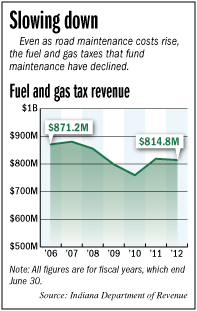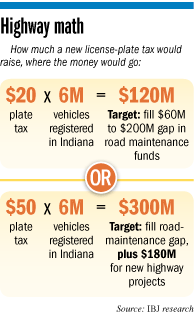Subscriber Benefit
As a subscriber you can listen to articles at work, in the car, or while you work out. Subscribe NowA license plate tax of $20 to $50 per car will be one of a raft of proposals considered by the Legislature next year as a way to fix a hole in funding for road maintenance.
And to keep expanding Indiana’s system of highways.
The plate-tax idea has been floated recently by Sen. Luke Kenley, R-Noblesville, as a way to help the Indiana Department of Transportation plug an annual budget hole of at least $60 million and as much as $200 million.
Kenley, the powerful chairman of the Senate Appropriations Committee, also said he’s looking at giving cities and towns—which by one estimate have collective road maintenance shortfalls of $500 million a year—the option to raise gas taxes to help maintain their roads.
 Kenley
KenleyAnd Kenley also would like new revenue to start planning for expansions of interstates 65 and 70—and to revive plans for the much-maligned Indiana Commerce Connector that would loop from Interstate 69 to the Indianapolis International Airport.
Gov. Mitch Daniels revived talk of the Commerce Connector with a comment during a speech on Dec. 6.
“Our road infrastructure is more critically important to us than it ever was,” said Kenley, sitting at a table in his fourth-floor office at the Indiana Statehouse. “Somehow this needs to become a renewed major initiative like Major Moves was for Mitch.”
Major Moves was Daniels’ project to lease the Indiana Toll Road for $3.8 billion, and use the money to fund a new round of road-building in Indiana. But by next summer, all those funds will be committed. And the ending of Major Moves funding is exposing both old and new cracks in Indiana’s system of highway funding.
Cam Carter, a lobbyist at the Indiana Chamber of Commerce, said Kenley’s plate-tax idea “triggers the gag reflex.” But he thinks it moves in the right direction, which is relying on user fees to boost funding for Indiana’s 12,000 miles of highways and interstates.
“We think we ought to get as close to a user-fee model as possible,” Carter said.
INDOT funds road maintenance and road building primarily from taxes on gas, diesel and some other fuels. The recession that started at the end of 2007 sent that revenue tumbling, from $881 million that year to $760 million in 2010, according to figures from the Indiana Department of Revenue.
Fuel tax receipts rebounded to $815 million this year, but INDOT doesn’t believe they’ll ever return to pre-recession levels.
The reason? The proliferation of fuel-efficient cars and trucks, including those that use hybrid electric-gas engines as well as those that run on natural gas—which right now is not taxed. With drivers using less gas, they pay less of the state’s 18-cent-per-gallon tax.
 Just this month, Indianapolis-based Monarch Beverage Co. said it would convert 80 percent of its trucking fleet to natural gas engines by 2015, and the city of Indianapolis announced it will switch its entire fleet of cars to either fully electric or natural gas engines by 2025.
Just this month, Indianapolis-based Monarch Beverage Co. said it would convert 80 percent of its trucking fleet to natural gas engines by 2015, and the city of Indianapolis announced it will switch its entire fleet of cars to either fully electric or natural gas engines by 2025.
With President Obama pushing federal fuel-efficiency standards to reach 55 miles per gallon by 2025, the consumption of fuel is likely to keep dropping, even as road use remains steady or continues to rise.
“It has recovered a little bit, since those 2009 numbers. But we’ve seen a leveling off now. So we don’t think it’s ever going to return to that 2006-2007 number,” said Troy Woodruff, chief of staff at INDOT. “The reason is, cars are more fuel-efficient.”
State shortfall
Woodruff’s boss, INDOT Commissioner Michael Cline, stunned many legislators in November when he testified at a budget hearing that INDOT has a $200 million budget shortfall.
That number consists of $70 million needed to help Indiana continue to draw down the maximum amount of federal road matching funding, and $130 million to do asphalt overlays, chip-and-seal projects, and other initiatives that help roads last longer.
The Legislature has numerous ways to play the shortfall, but all of them involve tradeoffs.
For one, it could stop diverting $150 million from fuel taxes that currently fund the Indiana State Police and the Bureau of Motor Vehicles—but the state would need to find other ways to fund those agencies.
Another solution might be to stop diverting some of the $550 million generated annually by Indiana’s 7-percent sales tax on gasoline and diesel. Right now, those funds flow to Indiana’s general fund and are used to support non-transportation spending.
“If we redirect the taxes we’re already assessing, the problem will take care of itself,” said Dennis Faulkenburg, president of Indianapolis-based Appian Inc., which does lobbying for the Build Indiana Council, a trade group representing road construction companies.
Indiana also could extend its fuel taxes to cover natural gas and perhaps other alternative fuels.
Or it could link its 18-cent-per-gallon gas tax to the annual rate of inflation, so its buying power would keep up with the rising costs of road repair. Similar proposals are being discussed in Washington, D.C., for the federal gas tax, which stands at 18.4 cents per gallon.
The cost of road repairs is closely tied to the price of oil, which is used in asphalt and to power road equipment, as well as to workers’ wages.
Kenley, who must balance the entire budget, is looking at generating new revenue—even though he acknowledges people are apt to “get all bent out of shape” about his talk of new taxes.
Kenley thinks a $20 plate tax, multiplied by the roughly 6 million cars on Indiana’s roads, would generate $120 million a year to help INDOT. If the tax were $50 per car, it would generate $300 million per year, which would provide a stream of revenue to start moving forward with new road projects.
Kenley wants to expand I-65 and I-70 to six lanes across the state, with the third and sixth lanes perhaps dedicated to truck traffic.
Preliminary work on such expansions is under way at INDOT, Woodruff said.
INDOT staffers are not working on the Commerce Connector, he said. The road project sparked intense opposition from residents in Hancock, Shelby and Johnson counties when Daniels proposed it in 2006.
“At a minimum, we have to start the discussion on the transportation infrastructure need,” Kenley said. After the major 2013 discussions over expanding Medicaid and education funding, he said, “I’m hoping that next in line is the transportation discussion.”
The debate seems likely to happen, given that multiple legislators already are preparing bills addressing the highway-funding problem.
For example, Rep. Ed Soliday, R-Valparaiso, chairman of the House Transportation Committee, said he’s writing a bill that would test a tax on the number of miles traveled by each vehicle in Indiana.
He acknowledged that some people would have privacy concerns about such a tax. But Soliday thinks it’s worth looking at, because it would be the most direct way of taxing users of roads—regardless of what fuel their vehicles are consuming.
 “As you move to more alternative fuels, you’re going to have to think in terms of other ways for paying for roads,” said Soliday, who has led study committees the past two years analyzing infrastructure needs and shortfalls in funding.
“As you move to more alternative fuels, you’re going to have to think in terms of other ways for paying for roads,” said Soliday, who has led study committees the past two years analyzing infrastructure needs and shortfalls in funding.
Kenley said he’s considered the vehicle-miles-traveled tax. To avoid privacy concerns, he said, he might allow motorists the option of submitting their travel miles to get a discount off the license plate taxes he wants to add.
Local solutions
While the state’s problems are thorny enough, fixing them at the local government level might be even more difficult.
Cities and towns receive a portion of the state and federal taxes raised from fuel taxes to fund road building and maintenance. In addition, counties can raise wheel taxes on cars, but they traditionally have been reluctant to raise taxes on constituents countywide, since projects tend to fall disproportionately in their largest cities.
A 2010 study by the Local Technical Assistance Program at Purdue University estimated that local governments in Indiana were running $500 million per year short on road maintenance funding.
The estimate received some criticism. But Soliday noted that, even if the gap is only half as large, it’s still a huge problem.
“We’re getting to the critical stage in the counties,” Soliday said.
That doesn’t mean lawmakers and lobbyists are likely to rally around Kenley’s solution of a local-option gas tax.
Faulkenburg, the transportation lobbyist, noted that fuel taxes are often paid by fuel distributors, not station owners. Since distributors transport fuel to multiple towns and counties, getting them to pay tax on only some shipments could be administratively difficult.
And many times, the counties that have lots of road traffic are not the ones that need extra funds, Faulkenburg added.
Christine Altman, a Hamilton County commissioner, said that because motorists are mobile, it could be hard for one city to fully or fairly tax its residents for their actual use of local roads.
“This is a severe problem at the local level, especially with bridges. And some communities are actually milling up roads they pave because they can’t pave them,” she said.
“The local option, I think some communities would appreciate it. I don’t want to take that off the table. But it may be more effective if we just raise the gas tax by 2 [percentage] points, or whatever. I can’t imagine an extra 2 cents on a gallon is going to be felt by consumers.”•
Please enable JavaScript to view this content.
